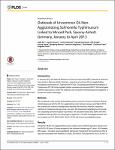Outbreak of Uncommon O4 Non-Agglutinating Salmonella Typhimurium Linked to Minced Pork, Saxony-Anhalt, Germany, January to April 2013
Alt, Katja
Simon, Sandra
Helmeke, Carina
Kohlstock, Claudia
Prager, Rita
Tietze, Erhard
Rabsch, Wolfgang
Karagiannis, Ioannis
Werber, Dirk
Frank, Christina
Fruth, Angelika
Introduction: In January 2013, the National Reference Centre for Salmonella (NRC) detected a salmonellosis cluster in Saxony-Anhalt, Germany, caused by uncommon O4 non-agglutinating, monophasic Salmonella (S.) Typhimurium DT193. Circulating predominant monophasic S. Typhimurium DT193 clones typically display resistance phenotype ASSuT. We investigated common exposures to control the outbreak, and conducted microbiological investigations to assess the strains’ phenotype. Methods: We conducted a case-control study defining cases as persons living or working in Saxony-Anhalt diagnosed with the O4 non-agglutinating strain between January and March 2013. We selected two controls contemporarily reported with norovirus infection, frequency-matched on residence and age group, per case. We interviewed regarding food consumption, especially pork and its place of purchase. We calculated odds ratios (ORs) with 95% confidence intervals (95% CI) using logistic regression. The NRC investigated human and food isolates by PCR, SDS-PAGE, MLST, PFGE, MLVA and susceptibility testing. Results: Altogether, 68 O4 non-agglutinating human isolates were confirmed between January and April 2013. Of those, 61 were assigned to the outbreak (median age 57 years, 44% female); 83% cases ≥ 60 years were hospitalized. Eating raw minced pork from butcheries within 3 days was associated with disease (31 cases, 28 controls; OR adjusted for sex: 3.6; 95% CI: 1.0-13). Phage type DT193 and MLST ST34 were assigned, and isolates’ lipopolysaccharide (LPS) matched control strains. Isolates linked to Saxony-Anhalt exhibited PFGE type 5. ASSuT- and ACSSuT phenotype proportions were 34 and 39% respectively; 54% were resistant to chloramphenicol. Three pork isolates matched the outbreak strain. Discussion: Raw minced pork was the most likely infection vehicle in this first reported outbreak caused by O4 non-agglutinating, mostly chloramphenicol-resistant S. Typhimurium DT193. High hospitalization proportions demand awareness on the risk of consumption of raw pork among elderly. LPS analysis indicated O4 expression; therefore, testing with antisera from different lots is recommendable in unexpected agglutination reactions.
No license information
Related Items
Show related Items with similar Title, Author, Creator or Subject.
-
2013-03-21ZeitschriftenartikelTyping of Salmonella enterica serovar Infantis isolates from 51 outbreaks in Germany between 1974 and 2009 by a novel phage-typing scheme Miller, Tatjana; Braun, Peggy; Fehlhaber, K.; Prager, Rita; Pfeifer, Yvonne; Rabsch, WolfgangWe developed a new phage-typing method and evaluated its application in combination with XbaI macrorestriction analysis by pulsed-field gel electrophoresis (PFGE) as a useful tool for the long-term epidemiology of Salmonella ...
-
2010-05-14ZeitschriftenartikelPork contaminated with Salmonella enterica serovar 4,[5],12:i:-, an emerging health risk for humans. Hauser, Elisabeth; Tietze, Erhard; Helmuth, Reiner; Junker, Ernst; Blank, Kathrin; Prager, Rita; Rabsch, Wolfgang; Appel, Bernd; Fruth, Angelika; Malorny, BurkhardSalmonella enterica subsp. enterica serovar 4,[5],12:i:- is a monophasic variant of S. enterica serovar Typhimurium (antigenic formula 4,[5],12:i:1,2). Worldwide, especially in several European countries and the United ...
-
2013-11-14ZeitschriftenartikelEvidence for the transmission of Salmonella from reptiles to children in Germany, July 2010 to October 2011 Pees, Michael; Rabsch, Wolfgang; Plenz, B.; Fruth, Angelika; Prager, Rita; Simon, Sandra; Schmidt, V.; Münch, Sebastian; Braun, PeggyThis study examines the Salmonella status in reptiles kept in households with children suffering from gastroenteritis due to an exotic Salmonella serovar, to obtain information on possible transmission paths. A number of ...

